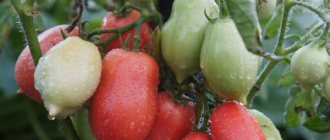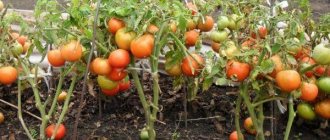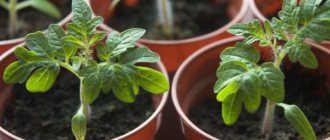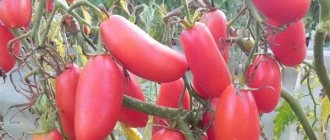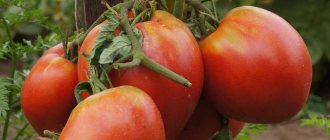History of origin
The tomato variety Russian Bells is listed in the State Register of Breeding Achievements as “Bells of Russia”. This is a “joint development” of the Institute of General Genetics named after N.I. Vavilov and the Rostock agricultural company, an achievement of a whole team of authors.
The Russian Bells tomato appeared on the market in 1999. A year later it was included in the State Register. There are no recommendations regarding the most suitable regions for cultivating these tomatoes; the variety is recognized as suitable for planting in any area.
Important! Russian bells are a variety of tomatoes. Seeds extracted from self-grown tomatoes are quite suitable for planting for the next season.
Tomato seeds Russian Bells are produced not only by the originator, but also by other agricultural companies under its license
Description of the tomato variety Russian Bells
Russian bells are an early ripening variety of tomatoes. Tomatoes reach full maturity 103-108 days after seed germination. The State Register recommends growing them in open ground, but they are also suitable for greenhouses, greenhouses, and film shelters due to their small dimensions.
In closed ground, the ripening period of the crop is reduced to 90-95 days
Determinate variety. This means that tomato bushes cannot “outgrow” the limit set by the breeders. Their height in open ground is 45-50 cm, in a greenhouse - a maximum of 60 cm. The plants are standard, “squat”, reminiscent of miniature trees. The shoots do not branch very readily, the foliage is average. The leaves are quite small, with a typical tomato shape.
The tomatoes are medium-sized, one-dimensional (52-55 g). The skin is smooth, glossy, pink-red in color. It is thin, but durable, and does not crack during prolonged waterlogging, transportation, storage, or heat treatment. Tomatoes are easily separated from the stalks due to the presence of articulation.
The shape of Russian bell tomatoes varies from plum-shaped with a pronounced “spout” to pear-shaped
The taste is characterized in the State Register as “excellent”. The tomatoes are noticeably sweet, but this is compensated by a light refreshing sourness. The pulp is raspberry-red, juicy, tender, but not watery. It is relatively dense, “grainy” when cut, with a pronounced “tomato” aroma. Russian Bell tomatoes have two seed chambers; there are few seeds, they are small, often underdeveloped.
Important! “Dwarf” tomatoes Russian Bells are quite suitable for planting in flowerpots and pots. They can be grown on a balcony, open veranda, terrace.
Watering, fertilizing
Carrying out the correct agrotechnical measures to care for planted seedlings guarantees good productivity of tomatoes of the “Bells of Russia” variety.
Watering
Material planted in open ground should be watered once every 4 days at the rate of 5 liters per 1 seedling. In greenhouse conditions, it is necessary to control the degree of soil moisture.
A dry surface up to 3 cm deep indicates the need for watering, which must be combined with weeding and hilling. To preserve moisture and avoid active growth of weeds, the ground around the tomato bushes can be mulched.
Top dressing
After 20-25 days after transferring the seedlings to open ground or a greenhouse, you should begin feeding the plants. For this, organic fertilizers (chicken manure, mullein) are best suited, which in dry form must be diluted in water in the correct proportions.
Feeding tomatoes with organic matter helps:
- increasing productivity;
- acceleration of fruit ripening;
- increasing disease resistance.
However, the proportions of dilution and use of organic fertilizers should be strictly observed to avoid the death of the plant from burns.
In addition, you can use complex mineral fertilizers with a predominance of phosphorus and potassium in their composition. After the formation of ovaries on the bushes, nitrogen fertilizers should be limited or completely abandoned. Otherwise, the set fruits may be dropped and the growth of tomato bushes may increase.
Characteristics of tomato Russian bells
The Russian Bells tomato bush looks very decorative during fruiting - it is literally strewn with tomatoes. But gardeners choose it not only for its visual appeal. The popularity of the variety is determined by its other important characteristics for the summer resident.
Tomato yield Russian bells
The yield for such compact bushes is quite high. With minimal care you can expect approximately 3 kg/m². Competent agricultural technology, combined with good weather, can increase yields to 8-9 kg/m².
Such indicators are ensured by the frequent arrangement of fruit clusters. The first is laid over the 6-7th sheet, then they are formed at intervals of 1-2 sheets. Each brush contains up to eight tomatoes (on average 5-6 pieces).
Important! In relation to the total volume of the harvest, the percentage of fruits that have a “marketable appearance” exceeds 90%.
Russian Bell tomatoes ripen en masse, but in several “waves”; because of this, fruiting lasts for a month and a half
Resistance to diseases and pests
Russian Bell tomatoes do not have “innate” immunity to diseases typical of Solanaceae. However, the general endurance and “stress resistance” characteristic of the variety allow it not only to successfully adapt to the climatic and weather characteristics of different Russian regions, but also to resist pathogenic microflora.
Russian bell tomatoes rarely get sick, even if fungi and viruses infect their “neighbors” in the garden. The same can be said about pests.
Application area
According to the purpose of the fruit, Russian Bells are a universal variety. They are good in salads and sliced fresh vegetables; thanks to their original shape, they can be used to decorate other dishes. This is a suitable “raw material” for homemade ketchup, tomato paste, and juice.
Many gardeners grow the Russian Bells variety only for pickling or pickling, noting the exceptional taste of such tomatoes. When prepared at home, they look very presentable.
Russian Bell tomatoes are also actively used for preparing soups and vegetable side dishes.
Characteristics of the variety
On one of the forums, a famous amateur gardener spoke about Pink Stella in the following way: “Today this is the best variety of early large pink-fruited tomatoes.”
The advantages and disadvantages of the Pink Stella tomato variety include a whole list in the first part, and among the disadvantages, only instability to late blight is mentioned, which can be avoided with high-quality prevention.
- An unpretentious variety for any weather conditions, suitable for all regions, including Siberia and the Urals, bears fruit well in the south, in hot areas.
- The yield is equally good both in greenhouses and in open beds.
- The bushes are compact and many gardeners like this variety as a compactor in beds with tall tomatoes that are grown in a single stem.
- The variety has a mid-early ripening period, and fruiting lasts until autumn.
- Productivity – from 8 to 15 kg per square meter.
Description of the bush
- Pink Stella is a determinate type variety; the height of the bushes does not exceed 50-60 cm.
- The stem is thick, erect, standard, but support is very desirable, since under the weight of large fruits it can fall on its side.
- Before the first cluster is tied, the bush is pyramidal, very compact, then it becomes a little spreading.
- The first ovary is formed above 7-8 leaves, a total of 4-5 - through the leaf, each with 3 to 7 tomatoes.
- The leaves are large, dark green, short petioles, no removal required.
- The bush itself stops growing after the last cluster is tied.
Description of fruits
As those who have been growing Pink Stella for many years say, and no one wants to lose this variety, these are very beautiful and tasty fruits:
- Tomatoes are elongated and have different shapes – pepper-shaped, kidney-shaped, heart-shaped. The sides are slightly flattened, the tip is slightly pointed.
- The average weight is 130-150 g, in the lower two clusters - up to 350 g, in the upper ones - about 100 g. They write on the forums that they managed to grow this tasty tomato weighing up to 0.5 kg!
- The color is attractive, raspberry-pink, there are no spots of green.
- The taste is very harmonious, sugar-sweet; on a 5-point scale, experts give it all 5 points. The variety is classified as a dessert salad type; it is recommended to be used fresh, for making juices, and for winter preparations.
- The pulp is moderately dense and juicy, the seed chambers are small, there are few small seeds. The skin is thin; when canning whole small fruits, it bursts, so they must be pierced at the stem.
- Pink Stella tomatoes ripen well, even when picked while still green, just like the Altai masterpiece. But the shelf life and keeping quality are not very long - about 2 weeks. They transport well if laid only in two rows.
Advantages and disadvantages
Russian Bell tomatoes have been consistently in demand by Russian gardeners for more than 20 years, thanks to a long list of their advantages:
- early ripening of tomatoes;
- “friendly”, but at the same time extended fruiting;
- endurance and “stress resistance”, ensuring stable harvests in different regions with very different climates and weather conditions;
- ease of cultivation, undemanding;
- possibility of cultivation in open and closed ground, in the garden or at home;
- good resistance to pathogenic microflora and pests attacking tomatoes;
- consistently good seed germination;
- the compactness of the plants, which makes it possible to “compact” the bushes without disturbing the planting pattern and makes it easier to care for them;
- one-dimensionality and external presentation of tomatoes, their original shape;
- excellent taste and versatility of tomatoes;
- good transportability and shelf life for tomatoes (up to 15-20 days).
The “presentation” of tomatoes certainly influences the choice of gardeners
During the entire period of cultivation of Russian Bell tomatoes, gardeners were unable to find any significant shortcomings. A relative disadvantage is the variety’s demands on the planting site and the need for regular fertilizing during the entire active growing season. But such “needs” are easily explained by high yields with small bushes.
Features of outdoor care
The effectiveness of growing tomatoes depends on compliance with agrotechnical rules at all stages of their growth.
Watering
To moisten the soil, it is better to use belt systems with a drip distributor. Each plant should receive 3 liters of water per day. In rainy weather, watering is not carried out.
Feeding
To accelerate growth and full fruiting, tomatoes need 4 main elements:
Plants can obtain these elements from organic compounds and mineral supplements.
It is best to alternate them, adding organic matter in liquid form at the root, and minerals in the form of spraying the bushes:
- The first fertilizing in the form of a solution of ash and superphosphate is applied at the time of transplantation.
- The second follows in 2 weeks. At this stage, a mullein solution of 300 ml is used for each bush.
- When buds begin to form on the plants, spray with monophosphate: 40 g of the substance is added to 10 liters of water.
- The following fertilizing in the form of a compost solution with yeast is applied after flowering: 10 kg of nettle, pour 20 liters of water, add 1 tbsp. l. sugar and a pack of dry yeast. Insist for 3 days. Then the concentrate is diluted with water in a 1:1 ratio and poured into the wells in 1-2 liters.
- During the fruit filling period, use the same solution, adding 30 g of dolomite flour to each well.
Pinching and tying up bushes
Pinching is carried out only at the moment of fruit formation and involves the removal of all leaves before the first ovary. During the same period, tomatoes begin to be tied up so that the bushes do not fall to the ground under the weight of the fruit. To do this, you can use sticks in the form of slingshots, which are installed under fruiting branches.
The shoots are fixed using elastic fabric. Old nylon tights are suitable for this.
Soil care
Loosening the soil and weeding are measures that speed up the supply of nutrients and eliminate the risks of developing fungal infections due to stagnation of water in the soil. Manipulations are carried out after watering and precipitation.
In the rows, the weeding depth is 10 cm, in the holes - 5 cm. After weeding, the soil is mulched. In extreme heat, compost or succulent greens are used for this; in rainy weather, dry sand or peat.
Features of cultivation
Russian gardeners traditionally prefer to grow tomatoes using seedlings. This also applies to the Russian Bells variety. Seedlings suitable for transplanting into soil are formed in 55-60 days.
Knowing how much time it takes to grow seedlings, and considering that tomatoes are planted in the ground only when the risk of return spring frosts is minimized, it is easy for the gardener to decide on the timing of planting seeds. In central Russia this is approximately mid-March, in the southern regions - 2-3 weeks earlier, in “risky farming zones”, on the contrary, later.
You can plant seedlings 12-15 cm high with 5-6 true leaves on the beds
It is advisable to immediately plant the seeds in separate containers, so that later you can “skip” the stage of picking the seedlings. If you use peat pots, you will not have to remove seedlings from them before planting them in the ground.
Seedlings will quickly adapt to the changed “habitat” and begin to grow in the garden if you begin to harden them a couple of weeks before transplanting. To do this, it is enough to place the containers outside every day, starting from 1.5-2 hours and ending with “overnight stays” in the open air.
Important! The formation of strong seedlings is impossible if the seedlings are not provided with at least 10-12 hours of daylight after germination and the substrate is not maintained in a moderately moist state.
A bed for Russian Bells tomatoes must meet several criteria:
- Good lighting.
- High nutritional value and at the same time looseness of the substrate. Its “poverty” can be compensated for by applying fertilizers when preparing the bed.
- Neutral or close to it acid-base balance of the soil.
Important! Per 1 m², place 3-4 Russian Bell tomato bushes. Leave 35-40 cm between seedlings, and maintain an interval of 40-50 cm between rows.
Direct sunlight for tomato bushes and fruits Russian bells are “harmless” even with prolonged exposure
The Russian Bells variety is suitable even for beginner gardeners. Agricultural technology includes:
- Watering. In the absence of precipitation, tomatoes planted in open ground are irrigated once every 3-4 days, spending about 5 liters of water per bush. In hot weather, the intervals are reduced to 1-2 days. In the greenhouse, the condition of the soil is determined by watering the tomatoes with Russian Bells when it dries 2-3 cm deep.
- Loosening and weeding. If you mulch the bed immediately after planting the seedlings, there will be no need for these activities. Otherwise, the bushes are loosened about once every week and a half, while simultaneously getting rid of weeds.
- Feeding. The first time tomatoes are fertilized 2.5-3 weeks after transplantation. To stimulate the growth of green mass, they need nitrogen. Then, until the end of fruiting, complex fertilizers for Solanaceae are used at intervals of 15-18 days.
- Bush formation. Tomatoes “lead” into 3-4 stems. They also need regular (once every 10-12 days) pinching and tying up of fruit clusters.
When grown in a greenhouse, stepchildren are removed more often - every 5-7 days
Important! Do not water Russian Bell tomatoes with cold, hard water. The method of watering should prevent drops of water from getting on the leaves, flowers and ovaries.
Landing
Seeds are sown from the 2nd-3rd decade of March. They use a loose nutrient substrate, which is prepared from such components
- like peat;
- sand;
- compost;
- vermiculite;
- and humus.
Seeds are placed in the grooves to a depth of 2 cm and at a distance of 3 cm. Sprinkle a thin layer on top.
What are the rules of care:
- irrigation through a sprayer or spray bottle;
- fertilizing 2 times (Kemira, Krepysh, nitroammofoska);
- diving when 2 leaves grow;
- hardening at 15 degrees for 7-10 days.
Pest and disease control methods
The general hardiness of Russian Bell tomatoes also includes their resistance to pathogenic microflora. Although the variety does not have “innate” immunity to any disease, they affect it extremely rarely. Pests are also not interested in them, even during “massive” invasions of the garden plot.
To avoid infection, the simplest preventive measures are enough. You need to choose the right place for planting Russian Bells tomatoes, avoid “crowding” in the garden bed and avoid serious mistakes in agricultural technology.
Before planting, it is recommended to treat Russian Bells tomato seeds in a fungicide solution
Bushes and soil are sprayed with copper-containing preparations if the weather is favorable for the activation of pathogens.
Important! If fruit ovaries have already formed on Russian Bell tomato bushes, they are treated only with biological products.
Useful video
| Super early | Mid-season | Mid-early |
| White filling | Black Moor | Khlynovsky F1 |
| Moscow stars | Tsar Peter | One hundred poods |
| Room surprise | Alpatieva 905 a | Orange Giant |
| Aurora F1 | Favorite F1 | Sugar Giant |
| Severenok F1 | La La Fa F1 | Rosaliza F1 |
| Katyusha | Right size | Em Champion |
| Labrador | Dimensionless | Sultan F1 |
If you find an error, please highlight a piece of text and press Ctrl Enter.
